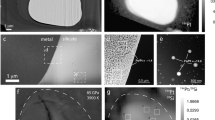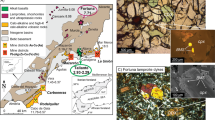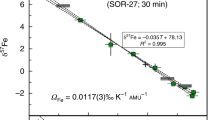Abstract
Understanding the geochemical behaviour of the siderophile elements — those tending to form alloys with iron in natural environments — is important in the search for a deep-mantle chemical ‘fingerprint’ in upper mantle rocks, and also in the evaluation of models of large-scale differentiation of the Earth and terrestrial planets. These elements are highly concentrated in the core relative to the silicate mantle, but their concentrations in upper mantle rocks are higher than predicted by most core-formation models1,2. It has been suggested that mixing of outer-core material back into the mantle following core formation may be responsible for the siderophile element ratios observed in upper mantle rocks3. Such re-mixing has been attributed to an unspecified metal–silicate interaction in the reactive D″ layer just above the core–mantle boundary4. The siderophile elements are excellent candidates as indicators of an outer-core contribution to the mantle, but the nature and existence of possible core–mantle interactions is controversial5. In light of the recent findings that grain-boundary diffusion of oxygen through a dry intergranular medium may be effective over geologically significant length scales6 and that grain boundaries can be primary storage sites for incompatible lithophile elements7, the question arises as to whether siderophile elements might exhibit similar (or greater) grain-boundary mobility. Here we report experimental results from a study of grain-boundary diffusion of siderophile elements through polycrystalline MgO that were obtained by quantifying the extent of alloy formation between initially pure metals separated by ∼1 mm of polycrystalline MgO. Grain-boundary diffusion resulted in significant alloying of sink and source particles, enabling calculation of grain-boundary fluxes. Our computed diffusivities were high enough to allow transport of a number of siderophile elements over geologically significant length scales (tens of kilometres) over the age of the Earth. This finding establishes grain-boundary diffusion as a potential fast pathway for chemical communication between the core and mantle.
This is a preview of subscription content, access via your institution
Access options
Subscribe to this journal
Receive 51 print issues and online access
$199.00 per year
only $3.90 per issue
Buy this article
- Purchase on Springer Link
- Instant access to full article PDF
Prices may be subject to local taxes which are calculated during checkout




Similar content being viewed by others
References
O’Neill, H. St C. The origin of the moon and the early history of the Earth—a chemical model. Part 2: the Earth. Geochim. Cosmochim. Acta 55, 1159–1172 (1991)
Jones, J. H. & Drake, M. J. Geochemical constraints on core formation in the Earth. Nature 322, 221–228 (1986)
Walker, R. J. & Walker, D. Does the core leak? Eos 86, 237–244 (2005)
Brandon, A. D., Walker, R. J., Morgan, J. W., Norman, M. D. & Pritchard, H. M. Coupled 186Os and 187Os evidence for core-mantle interaction. Science 280, 1570–1573 (1998)
Brandon, A. D. & Walker, R. J. The debate over core-mantle interaction. Earth Planet. Sci. Lett. 232, 211–225 (2005)
Van Orman, J. A., Fei, Y., Hauri, E. H. & Wang, J. Diffusion in MgO at high pressures: Constraints on deformation mechanisms and chemical transport at the core-mantle boundary. Geophys. Res. Lett. 30, 1056–1059 (2003)
Hiraga, T., Anderson, I. M. & Kohlstedt, D. L. Chemistry of grain boundaries in mantle rocks. Am. Mineral. 88, 1015–1019 (2003)
Hiraga, T., Anderson, I. M. & Kohlstedt, D. L. Grain boundaries as reservoirs of incompatible elements in the Earth’s mantle. Nature 427, 699–703 (2004)
Farver, J. R. & Yund, R. A. Measurement of oxygen grain boundary diffusion in natural, fine-grained, quartz aggregates. Geochim. Cosmochim. Acta 97, 1597–1607 (1991)
Kingery, W. D. Introduction to Ceramics 2nd edn 250–257 (Wiley, New York, 1976)
Fisher, J. C. Calculation of diffusion penetration curves for surface and grain-boundary diffusion. J. Appl. Phys. 22, 74–77 (1951)
Harrison, L. G. Influence of dislocations on diffusion kinetics in solids with particular reference to the alkali halides. Trans. Faraday Soc. 57, 1191–1199 (1961)
Ricoult, D. L. & Kohlstedt, D. L. Structural width of low-angle grain boundaries in olivine. Phys. Chem. Mineral. 9, 133–138 (1983)
Sutton, A. P. & Balluffi, R. W. Interfaces in Crystalline Materials 305–310 (Oxford Univ. Press, New York, 1995)
Watson, E. B. Mobility of siderophile elements in grain boundaries of periclase and periclase/olivine aggregates. Eos 83 (Spring Meet. Suppl.), abstr. V52B-05. (2002)
Ringwood, A. E. Phase transformations and their bearing on the constitution and dynamics of the mantle. Geochim. Cosmochim. Acta 55, 2083–2110 (1991)
Acknowledgements
This work was supported by a National Science Foundation grant to E.B.W.
Author information
Authors and Affiliations
Corresponding author
Supplementary information
Supplementary Figures
The file contains Supplementary Figures S1-S3 with Legends. (PDF 236 kb)
Rights and permissions
About this article
Cite this article
Hayden, L., Watson, E. A diffusion mechanism for core–mantle interaction. Nature 450, 709–711 (2007). https://doi.org/10.1038/nature06380
Received:
Accepted:
Published:
Issue Date:
DOI: https://doi.org/10.1038/nature06380
This article is cited by
-
Earth’s mantle composition revealed by mantle plumes
Nature Reviews Earth & Environment (2023)
-
Iron isotope fractionation at the core–mantle boundary by thermodiffusion
Nature Geoscience (2020)
-
Plume-subduction interaction forms large auriferous provinces
Nature Communications (2017)
-
First principles simulations of the stability and structure of grain boundaries in Mg2SiO4 forsterite
Physics and Chemistry of Minerals (2014)
-
Diffusion and partitioning of magnesium in quartz grain boundaries
Contributions to Mineralogy and Petrology (2014)
Comments
By submitting a comment you agree to abide by our Terms and Community Guidelines. If you find something abusive or that does not comply with our terms or guidelines please flag it as inappropriate.



